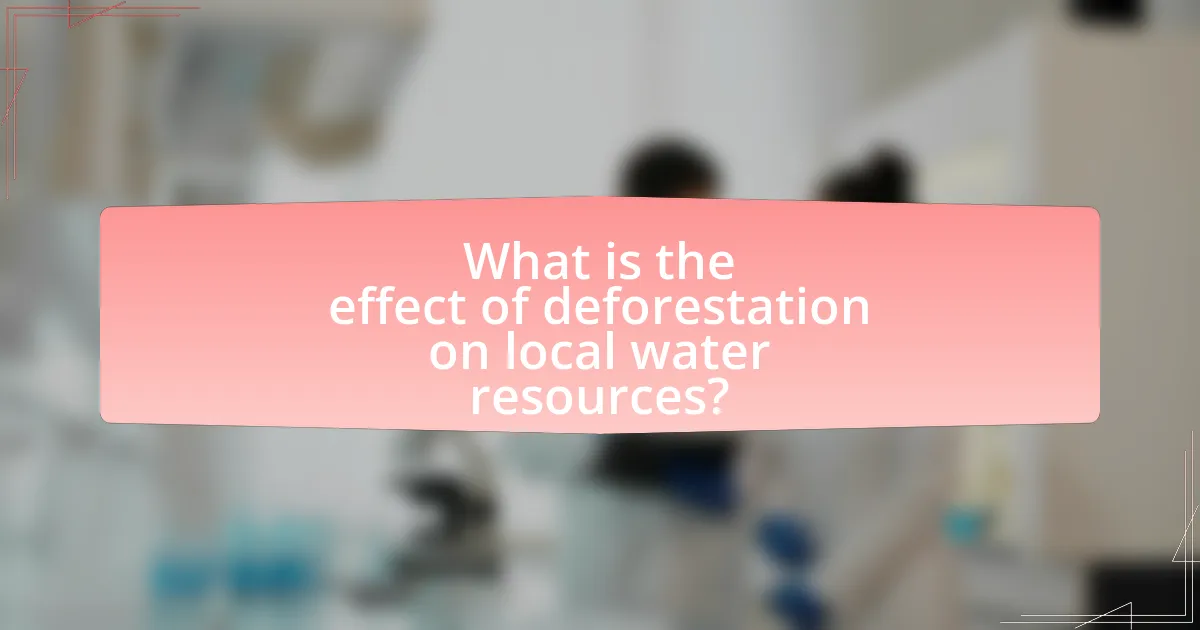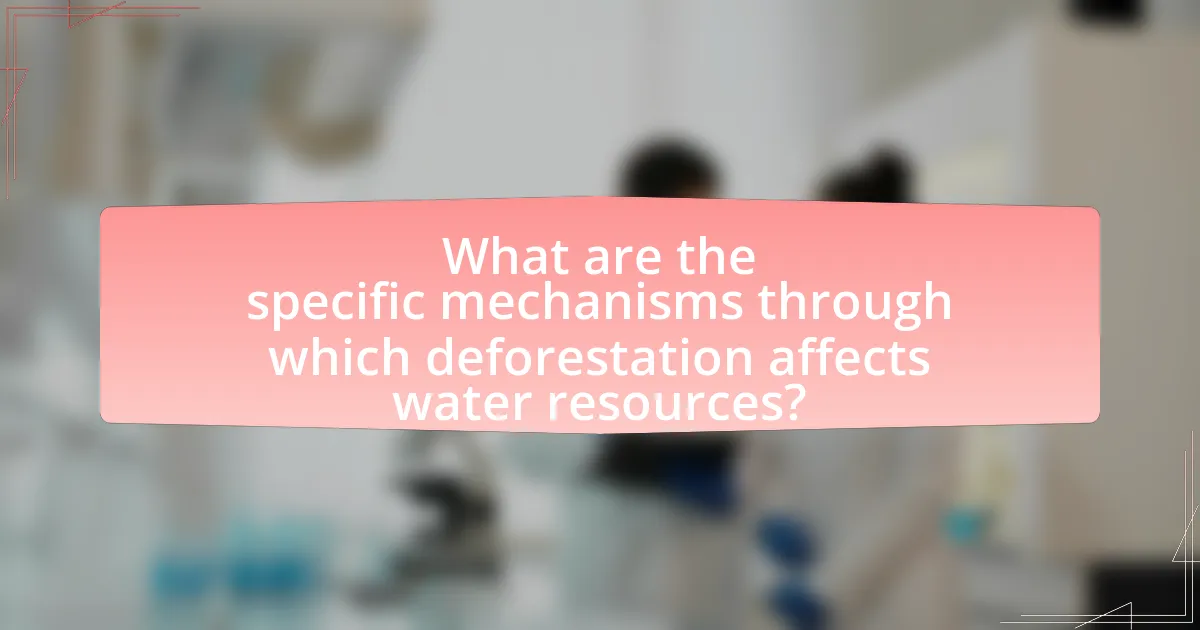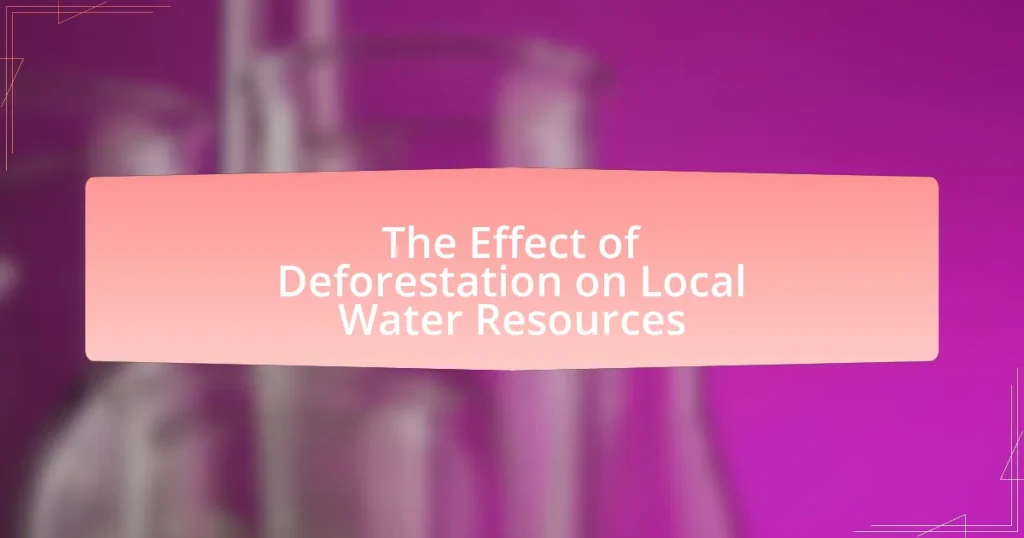Deforestation has a profound impact on local water resources by disrupting the hydrological cycle, leading to reduced groundwater recharge and increased surface runoff. The removal of trees diminishes transpiration, resulting in decreased rainfall and altered precipitation patterns, which can reduce streamflow by up to 50%. This article examines the mechanisms through which deforestation affects water availability, including soil erosion, sedimentation, and changes in groundwater levels. It also highlights the ecological consequences for ecosystems and local communities, emphasizing the importance of sustainable land management and reforestation efforts to mitigate these effects and preserve water resources.

What is the effect of deforestation on local water resources?
Deforestation significantly reduces local water resources by disrupting the hydrological cycle. Trees play a crucial role in absorbing rainfall and releasing water vapor through transpiration, which helps maintain humidity and precipitation patterns. When forests are cleared, this process is diminished, leading to decreased groundwater recharge and increased surface runoff. Studies indicate that areas with deforestation experience a reduction in streamflow by up to 50%, as reported in research published by the World Resources Institute. This alteration in water availability can lead to drought conditions, affecting both ecosystems and human communities reliant on these water sources.
How does deforestation impact the hydrological cycle?
Deforestation significantly disrupts the hydrological cycle by reducing the amount of water that is returned to the atmosphere through transpiration. Trees play a crucial role in this process; they absorb water from the soil and release it into the atmosphere, contributing to cloud formation and precipitation. When forests are cleared, this transpiration process diminishes, leading to decreased rainfall and altered local climate conditions. Studies indicate that areas with extensive deforestation can experience up to 30% reduction in rainfall, which directly impacts water availability for ecosystems and human use.
What are the key processes in the hydrological cycle affected by deforestation?
Deforestation significantly impacts key processes in the hydrological cycle, particularly precipitation, evaporation, and infiltration. The removal of trees reduces transpiration, which decreases atmospheric moisture and can lead to lower precipitation levels. Studies indicate that areas with extensive deforestation experience a reduction in rainfall by up to 30% due to diminished moisture recycling. Additionally, the loss of vegetation increases surface runoff and decreases soil infiltration, leading to higher rates of erosion and reduced groundwater recharge. This alteration in water flow dynamics can exacerbate flooding and drought conditions, further disrupting local water resources.
How does vegetation cover influence water retention and runoff?
Vegetation cover significantly enhances water retention and reduces runoff. Plants absorb rainfall through their roots, which allows water to infiltrate the soil rather than flow over the surface. This process is supported by studies indicating that areas with dense vegetation can retain up to 50% more water compared to bare soil. Additionally, vegetation slows down the movement of water, allowing more time for absorption and reducing the speed of runoff, which helps prevent soil erosion and maintains groundwater levels.
Why is understanding the impact of deforestation on water resources important?
Understanding the impact of deforestation on water resources is important because deforestation significantly alters hydrological cycles, leading to reduced water quality and availability. When forests are removed, the natural processes of water absorption and filtration are disrupted, resulting in increased runoff and sedimentation in water bodies. Studies indicate that deforestation can lead to a decrease in local rainfall by up to 30%, as trees play a crucial role in maintaining atmospheric moisture levels. Furthermore, the loss of vegetation can exacerbate flooding and drought conditions, affecting both ecosystems and human communities reliant on these water resources.
What are the ecological consequences of altered water resources?
Altered water resources lead to significant ecological consequences, including habitat degradation, loss of biodiversity, and changes in ecosystem functions. For instance, when water availability is modified due to deforestation, aquatic habitats can dry up, affecting species that rely on these environments for survival. Research indicates that deforestation can reduce local precipitation and increase runoff, which disrupts the natural water cycle and can lead to soil erosion and sedimentation in rivers. This sedimentation can smother aquatic habitats, further threatening fish populations and other aquatic organisms. Additionally, altered water resources can lead to the proliferation of invasive species, which can outcompete native species and disrupt local ecosystems.
How does deforestation affect local communities and their water supply?
Deforestation negatively impacts local communities and their water supply by disrupting the natural water cycle and reducing water quality. Trees play a crucial role in maintaining groundwater levels and regulating rainfall patterns; their removal leads to decreased soil moisture and increased runoff, which can result in water scarcity. A study published in the journal “Nature” found that areas with significant deforestation experienced a 30% reduction in streamflow, directly affecting the availability of clean water for local populations. Additionally, the loss of vegetation increases sedimentation in rivers, further degrading water quality and making it more challenging for communities to access safe drinking water.

What are the specific mechanisms through which deforestation affects water resources?
Deforestation affects water resources primarily through reduced transpiration, increased runoff, and altered hydrological cycles. When trees are removed, the process of transpiration, where trees release water vapor into the atmosphere, is diminished, leading to decreased atmospheric moisture and reduced precipitation. This reduction in moisture can lower local humidity levels, further impacting rainfall patterns. Additionally, the removal of vegetation increases surface runoff, as there are fewer roots to absorb water, leading to soil erosion and sedimentation in water bodies. This sedimentation can degrade water quality and disrupt aquatic ecosystems. Furthermore, deforestation disrupts the natural hydrological cycle, causing changes in groundwater recharge rates and potentially leading to water scarcity in affected areas. Studies have shown that regions experiencing significant deforestation can see a decrease in streamflow by up to 30%, highlighting the critical link between forest cover and water availability.
How does soil erosion relate to deforestation and water quality?
Soil erosion is significantly linked to deforestation and negatively impacts water quality. When trees are removed, the protective cover they provide is lost, leading to increased soil erosion as rainwater can wash away the topsoil more easily. This erosion not only depletes the soil of nutrients essential for plant growth but also results in sedimentation in nearby water bodies. According to a study published in the journal “Environmental Management,” deforestation can increase sediment runoff by up to 200%, which directly degrades water quality by introducing pollutants and reducing light penetration, affecting aquatic ecosystems. Thus, the relationship between soil erosion, deforestation, and water quality is critical, as it highlights the cascading effects of land use changes on environmental health.
What role does vegetation play in preventing soil erosion?
Vegetation plays a crucial role in preventing soil erosion by stabilizing the soil with its root systems. The roots of plants bind soil particles together, reducing the likelihood of soil displacement caused by wind and water. Additionally, vegetation acts as a barrier against rainfall impact, which can dislodge soil particles. Studies have shown that areas with dense vegetation experience significantly lower erosion rates compared to bare soil; for instance, a study published in the journal “Soil Science Society of America Journal” found that vegetated areas can reduce soil erosion by up to 90% compared to deforested regions. This demonstrates the essential function of vegetation in maintaining soil integrity and preventing erosion.
How does increased sedimentation impact local water bodies?
Increased sedimentation negatively impacts local water bodies by reducing water quality and disrupting aquatic ecosystems. High sediment levels can lead to decreased light penetration, which affects photosynthesis in aquatic plants and disrupts the food chain. Additionally, sediment can carry pollutants and nutrients that contribute to harmful algal blooms, further degrading water quality. Studies have shown that areas with significant sedimentation experience a decline in fish populations and biodiversity, as species struggle to adapt to altered habitats. For instance, research indicates that sedimentation can reduce the abundance of sensitive species by up to 50% in affected areas.
What changes occur in groundwater levels due to deforestation?
Deforestation leads to a decrease in groundwater levels. The removal of trees reduces transpiration, which is the process where trees release water vapor into the atmosphere, thereby diminishing local precipitation and soil moisture. A study by the Food and Agriculture Organization indicates that deforestation can reduce groundwater recharge by up to 50%, as the absence of vegetation allows for increased runoff and less water infiltration into the soil. This results in lower groundwater levels, affecting water availability for ecosystems and human use.
How does tree removal affect groundwater recharge rates?
Tree removal significantly decreases groundwater recharge rates. Trees play a crucial role in the hydrological cycle by facilitating water infiltration into the soil through their root systems and by reducing surface runoff. When trees are removed, the soil becomes compacted and less permeable, leading to increased runoff and decreased water absorption. Research indicates that areas with tree cover can recharge groundwater at rates up to 50% higher than deforested areas, as demonstrated in studies conducted in various ecosystems, including temperate forests and tropical rainforests.
What are the long-term implications of reduced groundwater levels?
Reduced groundwater levels lead to significant long-term implications, including decreased water availability for agriculture, drinking, and ecosystems. As groundwater supplies diminish, agricultural productivity declines due to insufficient irrigation, which can result in food shortages and increased prices. Additionally, lower groundwater levels can cause wells to dry up, impacting communities reliant on these sources for drinking water. Ecosystems also suffer, as reduced groundwater can lead to the degradation of wetlands and loss of biodiversity, disrupting habitats and species that depend on consistent water levels. Historical data indicates that regions experiencing prolonged groundwater depletion, such as California’s Central Valley, have faced severe droughts and economic challenges, underscoring the critical nature of maintaining groundwater resources.

What are the broader implications of deforestation on local water resources?
Deforestation significantly disrupts local water resources by reducing the capacity of ecosystems to regulate water cycles. Trees play a crucial role in maintaining groundwater levels and facilitating rainfall through transpiration. When forests are cleared, the loss of vegetation leads to decreased soil moisture retention, resulting in increased runoff and reduced groundwater recharge. Studies indicate that areas with deforestation experience a decline in streamflow by up to 30%, as reported by the World Resources Institute. Additionally, the alteration of natural water filtration processes can lead to increased sedimentation and pollution in local water bodies, further compromising water quality and availability for communities.
How does deforestation contribute to climate change and its effects on water resources?
Deforestation significantly contributes to climate change by increasing carbon dioxide levels in the atmosphere, which leads to global warming. Trees absorb carbon dioxide during photosynthesis; when they are cut down, this stored carbon is released, exacerbating the greenhouse effect. According to the Food and Agriculture Organization, deforestation accounts for approximately 10-15% of global greenhouse gas emissions.
The effects of climate change on water resources are profound. Altered precipitation patterns and increased evaporation rates can lead to droughts in some regions and flooding in others. For instance, a study published in the journal “Nature Climate Change” indicates that deforestation can disrupt local hydrological cycles, reducing rainfall and affecting water availability. This disruption can diminish the quality and quantity of freshwater resources, impacting agriculture, drinking water supplies, and ecosystems.
What is the relationship between deforestation and altered precipitation patterns?
Deforestation significantly alters precipitation patterns by disrupting the local hydrological cycle. Trees play a crucial role in maintaining moisture levels through processes like transpiration, where water is released into the atmosphere. When forests are removed, this moisture is reduced, leading to decreased rainfall and altered weather patterns. Research indicates that areas experiencing deforestation can see a reduction in precipitation by up to 30%, as evidenced by studies conducted in the Amazon rainforest, where deforestation has led to drier conditions and increased frequency of droughts.
How does climate change exacerbate water scarcity in deforested areas?
Climate change exacerbates water scarcity in deforested areas by altering precipitation patterns and increasing evaporation rates. Deforestation reduces the number of trees that can absorb and transpire water, leading to decreased local humidity and rainfall. According to a study published in the journal “Nature Climate Change,” regions experiencing deforestation face a 20% reduction in rainfall, which directly impacts water availability. Additionally, rising temperatures due to climate change accelerate evaporation from soil and water bodies, further diminishing water resources. This combination of reduced precipitation and increased evaporation creates a critical water shortage in deforested regions.
What strategies can be implemented to mitigate the effects of deforestation on water resources?
To mitigate the effects of deforestation on water resources, reforestation and afforestation strategies should be implemented. These strategies involve planting trees in deforested areas and establishing new forests, which help restore the natural water cycle by enhancing groundwater recharge and reducing surface runoff. Research indicates that forested areas can improve water quality by filtering pollutants and sediments, thus maintaining healthier water bodies. Additionally, implementing sustainable land management practices, such as agroforestry, can reduce soil erosion and maintain soil moisture, further protecting water resources. Studies show that regions with integrated watershed management, which includes tree planting and conservation practices, experience improved water availability and quality, demonstrating the effectiveness of these strategies.
What role do reforestation and afforestation play in water resource management?
Reforestation and afforestation significantly enhance water resource management by improving watershed health and increasing water availability. These practices restore vegetation cover, which helps to regulate the hydrological cycle by promoting groundwater recharge and reducing surface runoff. For instance, studies have shown that reforested areas can increase water yield by up to 30% compared to deforested regions, as trees facilitate the infiltration of rainwater into the soil. Additionally, afforestation can mitigate soil erosion, which protects water quality by preventing sedimentation in water bodies. Therefore, both reforestation and afforestation are crucial strategies for sustainable water resource management, directly impacting the availability and quality of water in local ecosystems.
How can sustainable land management practices help preserve water resources?
Sustainable land management practices help preserve water resources by promoting soil health, reducing erosion, and enhancing water retention. These practices, such as agroforestry and cover cropping, improve the soil structure, which increases its ability to absorb and retain water. Research indicates that implementing agroforestry can lead to a 30% increase in water infiltration rates compared to conventional farming methods. Additionally, sustainable practices minimize runoff and pollution, ensuring cleaner water sources. For instance, a study published in the journal “Water Resources Research” found that sustainable land management can reduce sedimentation in water bodies by up to 50%, thereby protecting aquatic ecosystems and maintaining water quality.
What are the best practices for protecting local water resources in the face of deforestation?
The best practices for protecting local water resources in the face of deforestation include implementing sustainable land management, restoring degraded ecosystems, and enforcing regulations on land use. Sustainable land management practices, such as agroforestry and reforestation, help maintain soil health and water retention, which are crucial for preserving water quality and availability. Restoring degraded ecosystems, particularly wetlands and riparian zones, enhances natural filtration processes and supports biodiversity, which is vital for resilient water systems. Enforcing regulations on land use ensures that deforestation activities are monitored and controlled, reducing the risk of water resource depletion. Studies have shown that areas with effective land management and restoration practices experience improved water quality and quantity, demonstrating the effectiveness of these strategies in mitigating the impacts of deforestation on local water resources.


